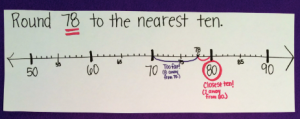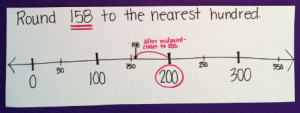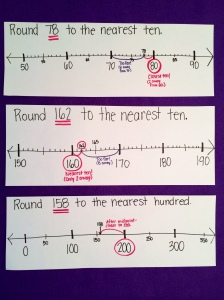Rounding is one of the worst things in the world to teach, right? It is classic every time. Mention rounding…kids sigh, teachers tense up and everyone’s brains feel muddled. It is HARD to understand rounding when you don’t have strong number sense.
I used to teach every trick under the sun for rounding. I tried the rounding mountain, I tried the rounding coaster. I even would break it down for kids and have them underline the place, circle the number next to it, check to see if it was 5 or higher. There were SO MANY problems. Kids couldn’t figure out the place value, where to start, what to change, what to look for or even what the number was in the end. A few students would understand it, and it would stay that way.
That was when I realized they weren’t understanding the concept behind the tricks. They couldn’t remember the rules of the tricks (not even when it was a rhyme, because they only memorized the rhyme and didn’t get how to use the trick).
So I threw all of it away. I took down all of my rounding roller coaster and rounding mountain anchor charts. I decided to start fresh. I told my students this year to FORGET everything they ever learned about rounding.
Then, we counted by tens. Not just 10, 20, 30, 40, 50 60, but also 110, 120, 130, 140, 150. We counted by hundreds in the same way. We talked about what nearest ten and hundred mean. We made number lines that counted by tens and hundreds. THEN, we began rounding numbers.
And this is what we came up with as a class:

It was so simple. If you are asked to round to the nearest ten, begin counting by tens by making a number line. Find the closer ten by checking how many spaces away it is from your number. As we worked with more numbers, they uncovered the mystery of the 5. “What do we do if it is in the middle?!” We round to the higher ten, because that is what the world decided to do so that everyone does it the same.
We could also round to the nearest ten in numbers in the hundreds, because we practiced counting by tens in the hundreds.

We can also round to the nearest hundred in this same simple way!

This whole entire thing was AMAZING. After several days of practice students weren’t drawing out number lines anymore, they were able to picture them in their heads.
On my pre-test I had 5 students who could round to the nearest ten and hundred. By the post-test every student except for ONE student could do it. Only one! I have been able to sit down with that student each day as he comes into school, and he’s getting it now, too.
It made me realize that tricks really aren’t for kids. When students don’t understand the WHY behind the trick, the tricks don’t work. If they don’t understand the number sense behind rounding, no matter what number they underline or look at, it won’t be solid conceptual understanding, and the trick will get mixed up.











